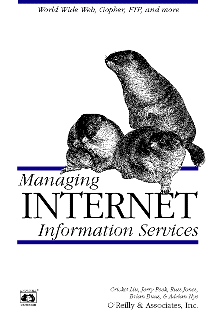![[Go to Content]](/images/uworld/tr-gotocontent.gif)
![[Search Editorial]](/images/uworld/tr-search-button.gif)
To help celebrate this first appearance of UnixWorld Magazine on the World Wide Web, I'm starting this month by reviewing books about information applications on the Internet. The first book--immediately following--covers setting up and running information servers and the second book looks at going beyond simple hypermedia in making information more accessible on the net.

By Cricket Liu, Jerry Peek, Russ Jones, Bryan Buus, and Adrian
Nye; with Greg George, Neophytos Iacovou, Jeff LaCoursiere, Paul
Lindner, and Craig Strickland
630 pages. Includes 19 pages of contents;
code; diagrams; contacts;
bibliography; 34 pages of index
ISBN 1-56592-062-7, paperbound, $29.95
Technical Level: computing--Expert or Wizard,
this subject--Novice or User
Information: concepts * *, practice * * *
Readability: textbook * *, reference * * *
Summary: The technical aspects of many Internet
information server packages, explained in varying depth.
Publisher: O'Reilly & Associates
To order directly from the publisher:
Gopher, World Wide Web, FTP, WAIS and Majordomo servers all get multiple chapters in this book. A lot of smaller information-server tools are covered at suitable length, too. Who would want a book on setting up, using and maintaining all these packages when no one site is likely to put up more than a handful of them? Especially when no book a mortal could lift off the shelf could go very deeply into all these complex packages?
Anyone who finds a package's documentation impenetrable, for starters. For most of these applications there are no other books in print that deal with their installation and administration. Information-server consultants and wannabees may want it as an orientation, a warm-up for the piles of manuals. Analysts should find this book deep enough to be very helpful in deciding which package is technically best for a particular site. And the book's hidden benefit, a brief course in managing information (as distinguished from managing the hardware and software that handle the information), might make the book worthwhile to people who primarily will deal with a server's information content.
When this many authors have a grip on the pencil, you can expect a book that varies in many qualities from one part to another. There are noticeable variations in technical depth here, but that's about the worst of the unevenness. The upside of very plural authorship is here, also--two good chapters on legal factors, which I didn't expect in a book this technical.
My one serious disappointment with this book is the major packages it covers. Frankly, the Internet community is stampeding toward World Wide Web as the information server of choice, and I don't know of anyone planning to set up a Gopher or WAIS server these days. The 10 chapters and 3 appendixes devoted to these waning packages might better have been used to cover Listproc, a mailing-list handler just as important as Majordomo.
In the book's favor, it contains a lot of useful information, and that information is much more accessible here than in the official manuals in most cases. Nor will there be rival books any time soon; I haven't read advance notices or even net rumors of any other books on most of these packages.
Gopher 2.x assigns a number of attributes to each file and directory. The default attributes for all items are set in the gopherd.conf file. You can set the name of the organization by changing the Org token, the physical location of the server by setting the Loc and Geog tokens, and the default language by changing the Language token. The gopherd.conf file also contains the server administrator's name and email address, set by the Admin and the AdminEmail tokens, respectively. Here are some sample settings for a fictitious server called ``The Wildlife Organization.''
Admin: Gopher Park Ranger AdminEmail: <gopher@wildlife.ora.com> Org: The Wildlife Organization Site: New York Wildlife Preserve Loc: 100 Elephant Avenue, Buffalo NY, 55405 Geog: 44 58 48 N 93 15 49 W Language: En_US
Edited by Raya Fidel, Trudi Bellardo Hahn, Edie M. Rasmussen,
and Philip J. Smith
306 pages. Includes 2 pages of contents;
tables; bibliographies; 8 pages of index
ISBN 0-938734-76-8, hardbound, $39.50
Technical Level: computing--User to Wizard,
this subject--Novice to Expert
Information: concepts * * *, practice * *
Readability: textbook * * *, reference * *
Summary: Facing some major gaps in current hypermedia practice
Publisher: Information Today
To order directly from the publisher:
Hypermedia, boolean text searches and the like are marvelous improvements in information access--as important as space between words in text, which was unknown in most medieval writings. But we're not even close to the ultimate in information accessibility with those.
Information retrieval specialists have long realized this, and they frequently think about better ways to access stored information. Some of their better ideas regarding machine-readable information are in the 15 separately-written articles in this book.
There aren't any canned algorithms here. The book's content is divided, roughly equally, into concepts for improving information access and analysis of problem areas still in need of solutions. Both categories deal mostly with matters that most of us have never realized are bottlenecks. For example, how many programmers have given much thought to indexing or searching for pictorial images, by semantic content rather than physical characteristics? The first three articles here evaluate a lot of good ideas, and still make it clear that a lot more thought is needed.
To borrow a buzzword from the suits, this is a book for proactive organizations. Those who only plan to produce smoother hyperlinks and more complex boolean searchers won't need it. But anyone who expects to be on the front edge of the next wave in online information access should read this book at least twice.